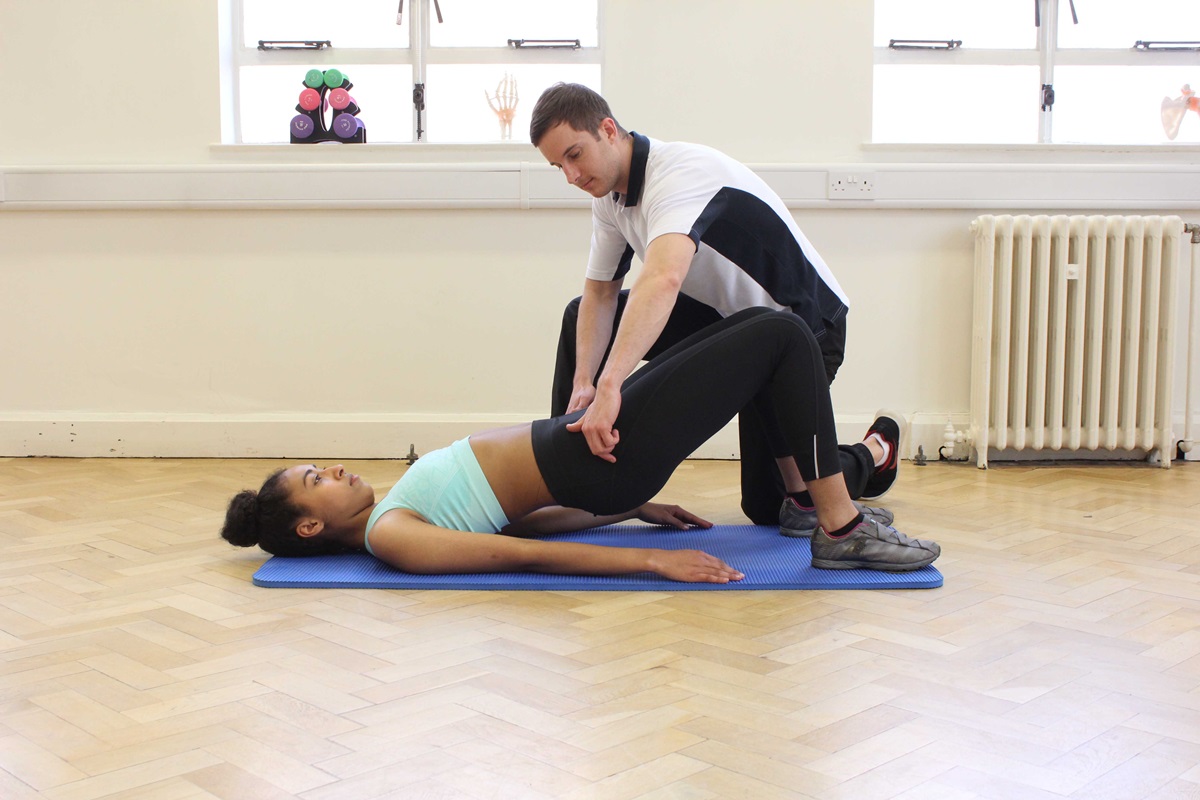A hip flexor strain can cause significant discomfort and affect daily activities, especially for athletes or anyone engaged in high-impact sports. Understanding the recovery time for a hip flexor strain is essential to ensure the right treatment and avoid future complications. This guide delves into the key aspects of hip flexor strain recovery time, from …
Hip Flexor Strain Recovery Time: Treatment, Tests, and Rehabilitation

A hip flexor strain can cause significant discomfort and affect daily activities, especially for athletes or anyone engaged in high-impact sports. Understanding the recovery time for a hip flexor strain is essential to ensure the right treatment and avoid future complications. This guide delves into the key aspects of hip flexor strain recovery time, from treatment options to rehab strategies, providing you with a clear path to recovery. Whether you’ve experienced a mild strain or a more severe injury, knowing what to expect and the steps involved will help you heal faster and return to your routine safely.
Understanding Hip Flexor Strain
The hip flexor muscles, including the iliopsoas, rectus femoris, and sartorius, are essential for movements like walking, running, and jumping. A strain occurs when these muscles or their tendons are overstretched or torn, leading to pain and reduced mobility. Understanding the nature of a hip flexor strain and the factors that influence its recovery can make a significant difference in your rehabilitation process. Whether you’re experiencing tight hip flexors due to overuse or have suffered a more severe muscle tear, the key to a successful recovery is timely treatment and appropriate rehabilitation.
In addition to their primary role in movement, the hip flexor muscles are crucial for stabilizing the lumbar spine. Tightness in the hip flexors can lead to increased pressure on the lower back, often resulting in discomfort or pain. This can cause significant impairments in both mobility and overall physical performance. As the hip flexors contribute to the alignment and functioning of the lower back, any strain or tightness in these muscles can exacerbate back issues, creating a cycle of pain and reduced performance. Thus, addressing hip flexor health is important not only for leg movements but also for maintaining optimal spinal health.
What Causes a Hip Flexor Strain?
Hip flexor strains are common injuries, especially among athletes and individuals who engage in high-impact sports like soccer, football, or basketball. Several factors can contribute to a hip flexor strain, and knowing these causes can help prevent future injuries.
Common Causes of Hip Flexor Strain
Hip flexor strains can occur for a variety of reasons, often linked to the intensity of physical activities or improper movement techniques. Understanding these common causes can help you avoid unnecessary injuries and keep your hip flexors in good health.
- Overuse, Improper Stretching, or Sudden Movements: Overexerting the hip flexors without adequate recovery can lead to a strain. For example, athletes engaging in repetitive sprinting or cycling may experience tightness and eventually strain their hip flexors. Improper stretching techniques or sudden, unprepared movements can also cause the muscles to overstretch, increasing the risk of injury.
- High-Impact Sports: High-impact activities like running, soccer, or basketball place significant stress on the hip flexors. Sudden acceleration or deceleration, jumping, and kicking motions are often responsible for these strains. In particular, athletes who frequently engage in activities that require quick changes in direction are more likely to suffer from hip flexor strains.
Risk Factors for Developing a Hip Flexor Strain
Certain individuals are at greater risk for hip flexor strains due to various risk factors. Understanding these can help mitigate the chances of developing a strain.
- Age, Muscle Imbalances, and Previous Injuries: Older adults or those with a history of hip flexor injuries may experience muscle imbalances or weakened tendons, which increase the risk of strains. In addition, compensatory injury from previous hip issues can place added stress on the hip flexors.
- Lack of Flexibility and Warm-Up Before Activity: Poor flexibility in the hip flexors or inadequate warm-up before physical activities is a significant contributor to strains. Without proper stretching, the hip flexors are more likely to be overstretched during sudden movements or high-impact exercises.
- Poor Posture and Walking Habits: Poor posture, particularly while standing or walking, can lead to hip misalignment, which in turn increases the strain on the hip flexor muscles. People with poor walking habits, such as improper foot placement or gait, may be at a higher risk of hip flexor strain.
Recent studies have shown that the incidence of hip flexor strains varies between men and women. In men, hip flexor strains occur at a rate of 1.81 per 10,000 athletic exposures (AEs), compared to a slightly lower rate of 1.59 per 10,000 AEs in women. In contrast, the rate of hip adductor strains is also higher in men at 1.71 per 10,000 AEs, while women experience these strains at a rate of 1.15 per 10,000 AEs. These figures highlight that while both men and women are susceptible to hip flexor strains, the injury rate tends to differ based on gender and activity levels.
Symptoms of a Hip Flexor Strain
Understanding the symptoms of a hip flexor strain is crucial for early diagnosis and treatment. The severity of the symptoms can vary depending on the grade of the strain, ranging from mild discomfort to debilitating pain.
What Does Hip Flexor Strain Feel Like?
The hallmark symptom of a hip flexor strain is pain in the front of the hip or upper leg area. The pain can be mild or sharp, and it may worsen with activities that involve hip flexion, such as walking, running, or climbing stairs. You may also experience stiffness or tightness, especially after sitting or standing still for an extended period.
Torn Hip Flexor Symptoms
A torn hip flexor is more severe and can cause intense pain, swelling, and bruising around the hip area. You may also feel a tugging sensation in the groin or experience muscle spasms in the hip or thigh. This type of injury may prevent you from performing basic movements like jumping, kicking, or sprinting, and can result in a significant reduction in mobility.
Hip Flexor Strain Test and Diagnosis

If you suspect a hip flexor strain, it’s important to seek a proper diagnosis. Healthcare providers typically perform a physical exam and may use imaging tests to confirm the severity of the injury.
Hip Flexor Strain Test
To diagnose a hip flexor strain, your treatment provider may perform a hip flexor strain test such as the straight leg raise, which involves lifting the leg while lying down to assess pain and mobility. Imaging tests like an MRI, X-ray, or CT scan may also be recommended to rule out other conditions, such as fractures or more severe tears.
Hip Flexor Strain Recovery Time
Understanding the recovery time for a hip flexor strain is crucial to managing expectations and following an appropriate treatment plan. The duration of recovery can vary based on the severity of the strain and the methods used for rehabilitation. In this section, we’ll explore the different recovery timelines for mild, moderate, and severe hip flexor strains, as well as what factors can impact healing.
How Long Does a Hip Flexor Strain Take to Heal?
The hip flexor strain recovery time varies depending on the severity of the strain, the type of treatment you undergo, and your overall health. A mild strain may heal within 1-3 weeks, while more moderate strains may take 3-6 weeks to recover. Severe strains, especially grade III strains, can take several months, requiring more intensive treatment and rehabilitation efforts.
Recovery Time for Different Grades of Hip Flexor Strains
The time it takes for a hip flexor strain to heal depends on the severity of the injury. There are three grades of hip flexor strains, and each grade requires different recovery approaches. Understanding the recovery time for each type can help you set realistic expectations and ensure appropriate treatment.
- Grade 1: Mild Strain Recovery Time: A Grade 1 strain, which involves only minor muscle overstretching, typically takes 1-3 weeks to heal. Rest, ice packs, and gentle stretching can aid in a quick recovery.
- Grade 2: Moderate Strain Recovery Time: A Grade 2 strain, characterized by partial muscle tears, takes 3-6 weeks to recover. This type of injury often requires physical therapy and activity modification to restore strength and flexibility.
- Grade 3: Severe Strain Recovery Time: A Grade 3 strain involves a complete tear of the muscle or tendon and may require surgical intervention. Recovery time can range from several months, especially if surgery is necessary, with long-term hip flexor strain rehab and rehabilitation exercises.
Hip Flexor Strain Treatment Options
Proper hip pain treatment is essential to managing discomfort and facilitating a faster recovery. Whether you’re dealing with a mild strain or a more severe injury, appropriate treatments can help minimize pain and promote healing. In this section, we’ll explore the most effective hip pain treatment methods available, from home remedies to professional interventions, ensuring you have the tools necessary to recover quickly.
Immediate Treatment for Hip Flexor Strain
When you experience a hip flexor strain, immediate treatment is essential to reduce pain and prevent further injury. The sooner you address the injury, the quicker your recovery time will be. The following first-line treatments are vital for managing the strain:
- Rest: Give the muscle time to heal by avoiding activities that strain the hip flexors.
- Ice: Apply an ice pack or cold therapy to reduce swelling and alleviate pain. Using an ice pack in the first 48 hours after the injury can be highly effective.
- Compression: A compression wrap or compression shorts can help control swelling and support the injured area.
- Elevation: Elevating the injured leg above the level of the heart helps reduce swelling.
Physical Therapy for Hip Flexor Strain Recovery
After the initial rest phase, physical therapy becomes a vital part of the recovery process. A physical therapist will guide you through gentle stretching exercises and strengthening routines, such as hip flexor stretching and exercises for the rectus femoris and sartorius muscles. Advanced exercises may include hip flexion and supine hip extension to restore strength and flexibility to the hip.
Surgical Options for Severe Hip Flexor Strain
In cases of severe strains, especially grade III strains, hip flexor strain surgery may be required to repair torn tendons or muscles. Minimally-invasive treatment options may be used depending on the severity of the injury.
How to Prevent Hip Flexor Strains

Preventing a hip flexor strain is far better than treating one. By understanding the causes and risk factors, you can take steps to reduce the chances of developing this type of injury. Here, we’ll discuss essential prevention techniques, including strengthening exercises and lifestyle adjustments that can help maintain the health and flexibility of your hip flexors.
Importance of Stretching and Strengthening Exercises
Regular stretching and strengthening exercises help prevent hip instability and maintain proper hip alignment. Effective exercises for hip alignment can target the iliopsoas and other muscles responsible for hip flexion, such as the pectineus. Incorporating both dynamic and static stretches into your routine can improve your flexibility and reduce the risk of injury.
Lifestyle Modifications to Avoid Hip Flexor Strains
Preventing hip flexor strains requires more than just strengthening exercises; lifestyle changes can also play a crucial role in reducing the risk. Making adjustments to your daily habits and activities can help protect your hips from strain and promote long-term joint health. Here are some effective lifestyle modifications to help you avoid hip flexor injuries:
- Activity Modification: Engage in low-impact activities like gentle swimming or cycling to give your hip flexors a break from high-stress movements.
- Balanced Diet and Healthy Weight: Maintaining a healthy weight can help alleviate excess strain on the hips and prevent injuries. Ensure your diet supports muscle recovery and joint health.
- Posture and Walking Habits: Practicing good posture and improving walking habits can help reduce undue stress on the hip flexors and prevent hip misalignment.
Road to Full Recovery: Managing Your Hip Flexor Rehab
Rehabilitation is a vital part of recovery after a hip flexor strain. To ensure full recovery and return to normal physical activity, it’s important to follow a structured rehab plan. This section will provide you with guidance on how to approach hip flexor strain rehab, including the best exercises and strategies to safely regain strength, flexibility, and mobility.
At Sustain Physical Therapy and Performance, we focus on helping active individuals recover from hip pain and injuries, including hip flexor strains, using a comprehensive, personalized approach. Our team of experienced physical therapists works closely with you to identify the root cause of your discomfort and develop a treatment plan tailored to your specific needs. Whether you’re dealing with a mild strain or a more complex injury, we offer cutting-edge techniques, including hands-on therapy, performance training, and rehabilitation exercises, to help you return to your favorite activities stronger than ever.
How to Safely Return to Physical Activity
Once you’ve recovered sufficiently, gradually return to physical activity. Start with low-impact exercises, and progressively increase the intensity as your hip becomes stronger. Listen to your body to avoid re-injury, and always follow your physical therapist’s guidance.
Long-Term Rehabilitation for Hip Flexor Health
After recovering from a hip flexor strain, continue practicing hip flexor stretching and strengthening exercises to maintain flexibility and prevent future strains. Additionally, regular biomechanical correction exercises can help improve posture and movement patterns to reduce the risk of injury.
Conclusion
Recovering from a hip flexor strain requires patience, proper treatment, and a well-structured rehabilitation plan. Whether you’re dealing with a mild strain or a severe strain, following the right recovery process will help you return to your normal activities with minimal risk of re-injury. Remember, hip specialists and orthopedic doctors are valuable resources to guide you through this recovery journey.
FAQs
What is the fastest way to heal a hip flexor strain?
The fastest way to heal a hip flexor strain is by following the R.I.C.E. method, incorporating cold therapy, and seeking professional treatment. Physical therapy and gentle stretching can also accelerate healing.
How long does a Grade 2 hip flexor strain take to heal?
A Grade 2 hip flexor strain usually takes 3-6 weeks to heal with appropriate treatment, including rest, compression wraps, and physical therapy exercises.
Should I stretch a pulled hip flexor?
It’s important to avoid overstretching a pulled hip flexor during the initial phase of healing. Once the pain subsides, gentle stretching and strengthening exercises are beneficial for recovery. Always consult a treatment provider for the right approach.
Dr. Adam Babcock PT, DPT
“We Help Active Adults Quickly Recover From Pain Or Injury So They Can Stay Active, Get Back To What They Love To Do, and Do It For Decades”






